The 1090 Megahertz Riddle (second edition)
Introduction
Background: The “death ray” that saves lives
Like many modern technologies such as computers, the internet, and GPS whose origins can be traced back to the military, aviation radar is no exception.
The fundamental theory of radar started in late 19th century. Since the 1860s, when the electromagnetic theory was discovered by James Clerk Maxwell, the foundation for many science and technology fields was laid out. In the late 19th century, Heinrich Hertz, who proved the existence of electromagnetic waves, also confirmed that metals could reflect radio waves. In the first decades of the 20th century, several systems for using radio waves to provide short-range directional information of objects were developed. German inventor Christian Hülsmeyer is often considered as the first person to use radio waves to detect metal objects in 1904.
However, not until the Second World War, was the concept of RAdio Detection And Ranging (RADAR) developed. The technology was simultaneously researched by both major Allies and Axis countries. However, the United Kingdom led the race in developing a functional radar system.
Originally, British Air Ministry officials, who were concerned about falling behind the technology race with the Germans, advised physicist Robert Watson Watt to propose a set of abstract technical challenges to his colleague Skip Wilkins:
"Suppose, just suppose, that you had eight pints [17kg] of water, 3,000ft [1km] above the ground. And suppose that water was at 98\(^\circ\)F [37\(^\circ\)C], and you wanted to heat it to 105\(^\circ\)F [41\(^\circ\)C]. How much radio frequency power would you require, from a distance of 5km?"
Both scientists understood very well that the average adult human has 17 kg blood and a critical body temperature of 41\(^\circ\)C. This represented an idea of the death ray that could be used to disable enemy aircraft pilots.
Without even developing such a system, they figured out that the power requirement was far beyond practice at that time. However, they realized an opportunity for funding a different project. Given the amount of power that can be transmitted, it was possible to detect the reflection of aircraft, and, thus calculate the position of aircraft. This proposal was approved by the air ministry. Later on, this technology was developed and shared with Americans during the war. After that, the widespread usage of RADAR (which later became radar) had begun.
After the war ended, radar became more and more important for civil aviation. With the rapid growth of commercial flights, it developed into a prominent technology for aircraft surveillance in the aviation industry.
The primary radar
Aircraft surveillance in the early days relied only on, what is known today as, the primary surveillance radar (PSR). The concept of PSR is fairly simple. It is a rotating radio transponder with an omnidirectional antenna. Commonly, the radar transmits a one-microsecond pulse for every one millisecond and listens to the reflections from the airplanes. The position of the aircraft is measured by the distance and angle to the radar. The distance is known as the slant distance, which is the line-of-sight distance between an aircraft and the radar. It can be calculated by measuring the time difference between the original signal and the reflection received, since the speed of the radio wave (speed of light) is known. The azimuth angle1 of the aircraft is determined by the rotation angle of the radar. By processing radar signals, technologies like phase filter and Doppler filter can be used to filter out moving targets like aircraft and remove static objects, such as mountains, buildings, and other obstacles.
The slant distance of an aircraft does not always correspond to the horizontal distance to the radar. This is because all points having the same slant distance are located on a sphere that has the radius equal to the distance. Since the civil radar usually does not provide elevation information on the target, it is not possible to accurately convert the slant distance to the horizontal distance. Historically, it is sufficient to use primary radar for separating airplanes without considering these altitude differences. However, other systems have to be in place to provide air traffic controllers more accurate positions of the aircraft.
The secondary radar
The secondary surveillance radar (SSR), also known as the air traffic control radar beacon system (ATCRBS), was designed to provide air traffic controllers more information than what is provided by the primary radar. The secondary radar can be installed separately or installed on top of the primary radar. It uses a different radio frequency to actively interrogate the aircraft and receive information transmitted by the aircraft.
The SSR transmits interrogations using the 1030 MHz radio frequency and the aircraft transponder transmits replies using the 1090 MHz radio frequency. In the early design of SSR, two civilian communication protocols (Mode A and Mode C) were introduced. Mode A and Mode C respectively allow the SSR to continuously interrogate the identity (squawk code) and the altitude of an aircraft. The squawk code in Mode A is a unique 4-octal digit code given by air traffic controllers to aircraft in their flight information region for identification. The altitude in Mode C refers to the barometric altitude obtained from the aircraft’s air data system.
Although Mode A and Mode C provide additional information to air traffic controllers, they present several design challenges [ICAO 1983]. The secondary surveillance radar initiates Mode A and C interrogations with two different pulse patterns, which are shown in Figure 1.1.
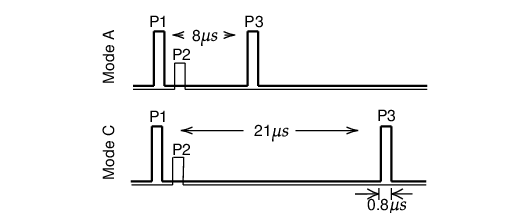
The pulses are about 0.8 μs wide. P1 and P3 are the two main pulses sent by the directional antenna. They are separated by 8 μs and 21 μs, respectively for Mode A and C. P2 is a pulse emitted through the omnidirectional antenna right after P1. Pulse P2 is introduced for sidelobe suppression [Orlando 1989]. When the power of P2 is higher than P1, the interrogation is likely from the side lobes of the directional antenna and should be ignored by the aircraft. This is can happen when the aircraft is close to the radar.
Figure 1.2 shows an example of a Mode A/C reply. Each reply consists of two persistent pulses, F1 and F2, separated by 20.3 μs. Within this period, either the identity code or the altitude code is encoded using 13 pulses of 0.45 μs. The pulses are separated by gaps of 1 μs. The pulse at the center serves as a verification pulse and is always absent. The presence or absence of any of the other 12 pulses represents a 1 or 0 bit. When required by air traffic controllers for identification purposes, a special purpose identification (SPI) may follow F2 after two absent pulses.
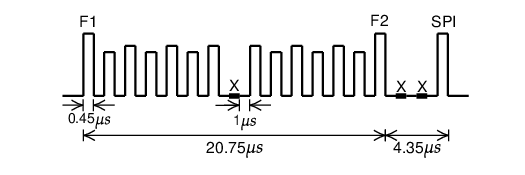
The response type (A or C) cannot be identified based on the reply signal itself. The SSR determines the content based on the synchronization with interrogations. This design of ATCRBS works sufficiently well with low-density air traffic, but it cannot efficiently cope with higher flight densities since all aircraft replies are transmitted on the same frequency. When several aircraft are in the same direction of the radar beam, reply signals can overlap and introduce errors for decoding. This is known as synchronous garbling.
When there are multiple secondary radars in the vicinity, replies originated by other radars may be considered as valid responses of one radar, which in turn, causes errors and confusion. This syndrome is called FRUIT (False Replies Unsynchronized In Time).
Though some of the garbling and the FRUIT problems can be mitigated with the reduction of interrogation frequency and improvements in signal processing ability, the information transmitted in Mode A and Mode C is still very limited. The number of identity codes available in Mode A communication is limited to a maximum of 4096 (\(8^4\) given the 4 octal digits) unique codes, which poses another clear limitation.
Hence, more advanced communication protocols needed to be developed to acquire more information from a large number of aircraft.
Mode S
Mode S (Mode Select Beacon System) was designed by Lincoln Laboratory at Massachusetts Institute of Technology in the 1970s. Based on different iterations of hardware and software design in the 1980s, the implementation of Mode S in air traffic control began in the 1990s. Since then, Mode S has become one of the main sources for aircraft surveillance.
The main characteristic of Mode S is its selective interrogation, which allows the SSR to interrogate different information from different aircraft separately. By using selective interrogation, it largely mitigated the problem of garbling in Mode A/C and thus greatly improved the capacity of the communication channel.
Unlike the limited number (4096) of unique identification codes in Mode A communication, the Mode S transponder is identified by a 24-bit transponder code, which can support up to 16,777,216 (\(2^{24}\)) unique addresses. In addition to these two major advantages, the Mode S protocol introduced many different types of information that could be interrogated and downlinked.
Mode S interrogations
The Mode S uplink signal contains parameters that indicate which information is desired by the air traffic controller. There are two types of Mode S interrogations, which are shown in Figure 1.3. The short interrogation has 56 bits of information contained in the data block, while the long interrogation contains 112 bits of information. The P2 pulse acts as the sidelobe suppression for Mode A/C transponders so that they will ignore the rest of the interrogation pulses. Information in the Mode S interrogation data block uses the Differential Phase-Shift Keying (DPSK) modulation [Mazda 2014].
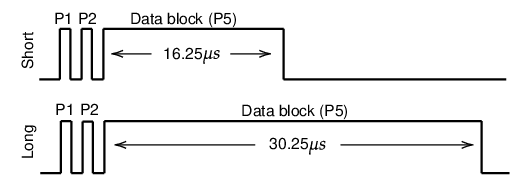
Mode S replies
There are two types of Mode S downlink signals, the short reply and the long reply, which correspond to the short and long interrogations from the SSR. For each microsecond, one bit is transmitted. All Mode S replies start with an 8 μs fixed preamble and continue with 56- or 112 μs data block. The structure of the downlink message is shown in Figure 1.4.
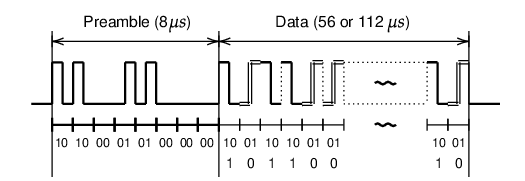
The 16-bit fixed preamble can be represented as 1010000101000000 in binary. The information contained in the data block is modulated using the Pulse Position Modulation (PPM), which is a type of amplitude modulation. In PPM, the 1 bit is represented by a 0.5 μs of pulse followed by a 0.5 μs flat signal. The 0 bit is reversed compared to the 1 bit, which is represented by a 0.5 μs flat signal and followed by a 0.5 μs pulse.
Note Mode S uplink and downlink signals use different modulation methods. The uplink uses phase modulation, while the downlink uses amplitude modulation. Phase modulation requires slightly more complicated hardware implementation but has a better performance in terms of error tolerance.
Compatibility with Mode A/C
Similar to Mode A/C, Mode S SSR can send All-Call interrogations to all aircraft in the vicinity. The All-Call interrogation is designed to be compatible with Mode A/C transponders. Figure 1.5 shows the pulses of an All-Call interrogation. There are 8 or 21 μs between P1 and P3, which is the same as Mode A/C. P4 is a wider pulse lasting for 1.6 μs.

When a Mode A/C transponder receives this interrogation, the last pulse P4 is ignored. Hence, a normal Mode A or Mode C reply is transmitted. A Mode S transponder would detect P4, and thus, produce a Mode S All-Call reply. The Mode A/C/S All-Call reply is designed for SSR to identify which aircraft are in the vicinity, including Mode A/C only aircraft.
This is one of the several different interrogation pulse patterns from a Mode A/C compatible Mode S radar. In addition, Mode S SSRs can perform both Mode A/C and Mode S interrogations.
Note The Mode A/C/S All-Call is being phased out, as new transponders stop replying to this type of interrogations. It is common for Mode S SSR makes use of Mode S only All-Call interrogation with the standard Mode S uplink (format 11) as shown in Figure 1.3.
Mode S format
The Mode S communication protocol is designed to handle different types of uplink and downlink message formats. The first five bits of the message define the uplink format (UF) or downlink format (DF) number of the message. Based on the UF/DF number, different structures of the data block are presented. Table 1.1 shows all available Mode S formats. Currently, 11 Mode S formats are being used. Numbers not in this table are reserved for future use.
| UF/DF | Bits | Uplink type | Downlink type |
|---|---|---|---|
| 0 | 56 | Short air-air surveillance (ACAS) | Short air-air surveillance (ACAS) |
| 4 | 56 | Surveillance, altitude request | Surveillance, altitude reply |
| 5 | 56 | Surveillance, identity request | Surveillance, identity reply |
| 11 | 56 | Mode S All-Call | All-Call reply |
| 16 | 112 | Long air-air surveillance (ACAS) | Long air-air surveillance (ACAS) |
| 17 | 112 | - | Extended squitter |
| 18 | 112 | - | Extended squitter/non transponder |
| 19 | 112 | - | Military extended squitter |
| 20 | 112 | Comm-A, altitude request | Comm-B, altitude reply |
| 21 | 112 | Comm-A, identity request | Comm-B, identity reply |
| 24 | 112 | Comm-C (ELM) | Comm-D (ELM) |
Note Format number 24 is an exception. It is identified using only the first two bits, which must be 11 in binary. All following bits are used for encoding other information.
We can see that the short 56-bit data block is used to encode messages with format numbers from 0 to 11. Messages with format numbers above 16 are encoded with the long 112-bit data block. Among all uplink formats, UF 17, 18, and 19 are not used. This is because the corresponding downlink messages (extended squitter messages) are designed to be broadcast automatically without the need for SSR interrogations.
One of the most common applications for the extended squitter is the Automatic Dependent Surveillance-Broadcast service, which is commonly known as ADS-B.
ADS-B
Automatic Dependent Surveillance-Broadcast (ADS-B) is a surveillance technology designed to allow aircraft to broadcast their flight state periodically without the need for interrogation. The word automatic refers to the fact that no inputs from controllers or pilots are required. The word dependent indicates this technology depends on information from other onboard systems, such as air data systems and navigation systems. ADS-B only become possible because of Global Navigation Satellite Systems (GNSS), such as Global Positioning System (GPS), which is the first GNSS system made available for civil usage by the USA after the Korean Air Lines Flight 007 accident in 1983.
Common aircraft state parameters included in ADS-B are position, altitude, and speed. The position is determined by GNSS and air data systems. The velocity is derived from the GNSS position and the inertial measurement system. The altitude information includes both barometric altitude and GNSS altitude. The barometric altitude is provided by the air data system. In addition to these primary state parameters, ADS-B also allows other information to be broadcast, for example, aircraft call-sign, accuracy indicators, integrity indicators, and operational status.
It is worth emphasizing that ADS-B is a broadcast-based surveillance system. Unlike other types of Mode S surveillance, no surveillance interrogation is required. The decoding of ADS-B messages is also easier than other Mode S messages because the message type and structure are clear for each individual message.
Different types of ADS-B messages are identified by Type Codes. The structures of these messages are all defined in ICAO documents, such as in [ICAO 2008] and [RTCA 2011]. In Part I of this book, we will explain how these different types of ADS-B messages can be decoded.
Note In this book, ADS-B only refers to the ADS-B standard implemented through Mode S extended squitter. Originally, there were three candidates to build ADS-B: Mode S Extended Squitter, VHF Data Link - Mode 4 (VDL4), and Universal Access Transceiver (UAT). Different specifications are designed for these frequency channels [RTCA 2011; RTCA 2002]. However, the Mode S extended squitter implementation of ADS-B is the most adopted one among all candidates. UAT is only partially implemented in some countries like the USA, while VDL4 did not go beyond the testing phase.
Other Mode S services
The most common data format number used in Mode S for information downlink are 4, 5, 20, and 21. Format 4 and 5 are short messages designed to acquire aircraft altitude and identity (similar to Mode A/C messages). Downlink messages with format 20 or 21, as known as Comm-B messages, contain other information desired by air traffic controllers, in addition to altitude and identity.
In theory, up to 255 different message types are supported by the Mode S Comm-B. A new parameter, Comm-B Data Selector (BDS), is designed to identify which additional information is included in Mode S messages. It functions similarly to the Type Code of ADS-B message. In practice, not all 255 BDS codes are defined or used.
A subgroup of these codes is commonly interrogated by surveillance radars. By combining different BDS codes into groups, several Mode S services are defined. The two most used services are Mode S Elementary Surveillance (ELS) and Mode S Enhanced Surveillance (EHS) [Grappel et al. 2008]. For example, in the European airspace, aircraft above a certain takeoff weight category are required to have these capabilities enabled.
The Mode S Elementary Surveillance consists of four BDS codes (10, 17, 20, and 30). It provides basic information such as Mode S capabilities and identification (callsign), in addition to the altitude or identity (squawk code) information.
The Mode S Enhanced Surveillance consists of three BDS codes (40, 50, and 60). It provides much more additional information on aircraft states, such as selected altitudes, true airspeed, indicated airspeed, Mach number, bank angle, and turn rate.
In addition to the common ELS and EHS, the meteorological routine air report (MRAR), and the meteorological hazard report (MHR) are also interrogated in some controlled airspaces. These reports provide weather-related information such as wind and temperature that are measured by the aircraft sensors. Another important service, Airborne Collision Avoidance System (ACAS), also uses the Mode S transponder for communication. All these services will be explained in details in this book.
Summary
Figure 1.6 illustrates all aforementioned Mode S services and their relationships with different Mode S downlink formats. This book covers all Mode S messages except DF19 and DF24 from this figure.
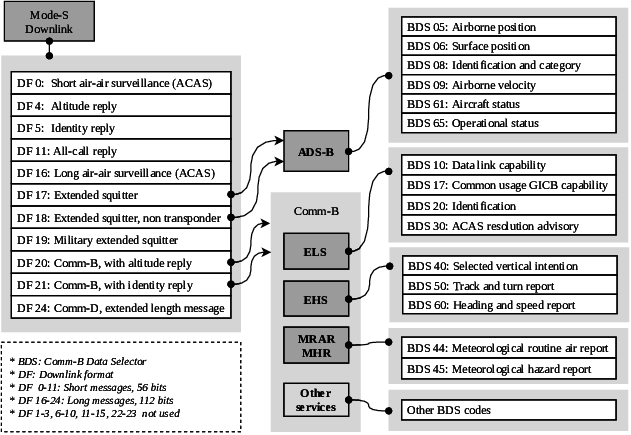
In the rest of this book, the details of these services are discussed in separate chapters. In Chapter 2 (the rest of part I), common hardware and software setups are shown. In Chapters 3 to 10 (part II), the focus is on ADS-B messages. Detailed guides on how to decode different types of messages are presented. In Chapters 11 to 19 (part III), the focus is on Mode S ELS, EHS, and meteorological services. Accordingly, the decoding and inference of the messages are provided.
Azimuth angle is the horizontal angle measured clockwise to the north of the observer.↩︎